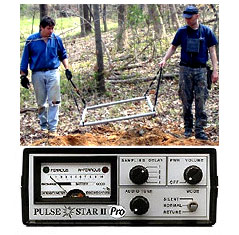Pulse Star II PRO - a Deep Seeking PI Metal Detector I Have Used since 2006
My Review on Pulse Star II Pro and Operation Tips for Beginner-Users
by Sergei UpstateNY, proficiency level: Beginner, last time modified:
Pulse Star II Pro has been a reputable leader in its class of deep seeking metal detectors on the market, and gained high popularity for its superiority over VLF 'deep seekers'.

Pulse Star II Pro is a Pulse-Induction Deep Seeking metal detector made by TB Metal Detectors in Germany. Operating it requires a couple of specific skills and a lot of patience. If you master this machine and bring it to a potentially good hunt site, you will be surprised by the detector's reliability and efficiency. I have used the Pulse Star II Pro during numerous relic and cache hunting outings, and the search results were amazing.
As any Pulse Induction (PI) metal detector, Pulse Star II Pro does not have the Discrimination function, i.e. it detects all metal objects. Even though the PS II Pro has two LED indicators - green for iron targets, and red - for non-ferrous targets, these LED indicators are effective only with large and shallow targets, i.e. when the target's signal is strong enough (indicated by the gage meter). However, even in such cases, this LED-indication is only 50% correct.
The Halo Effect is a major factor that affects the LED indicators' accuracy, thus rendering them inefficient. This was not crucial for the search process and really did not matter to me as I would rather dig up every 'large' and deep signal while cache or relic hunting. In my opinion, the LED-indication is unnecessary and should not be paid attention to.
The Pulse Star II Pro is really simple to operate if you read, fully understand and carefully follow the instructions. The most important characteristic of Pulse Star II Pro is its reliability: it never gives out a false signal, and if there is a metal object within a detecting range underground, the Pulse Star II Pro would not fail to indicate it. And the PS II Pro is NOT affected by ground mineralization!
Delay function is a key-feature of the Pulse Star II Pro and has four operating modes (sensitivity settings). A setting '1' is the most sensitive and can detect targets of a medium-sized nail and larger. A setting '4' is for detecting only targets of a size of a beer can and larger while completely ignoring the smaller objects. The settings '2' and '3' are in between the most sensitive and less sensitive levels.
If you operate the Pulse Star II Pro in the Delay setting '1', prepare yourself for digging a lot of shallow, small trash as the Pulse Star II Pro would not be able to 'ignore' it due to the highest sensitivity. But even if you select the Delay setting '4', you will hear responses to shallow small targets such as the medium-sized nails. This is why it is recommended to clean a search area of any shallow, medium- and large-sized targets before searching for deep targets. Usually a regular metal detector with the All-Metal mode is used for the shallow-target cleaning to save time.
The best way to distinguish a response to a deep, large target from responses to shallow and smaller targets is to count steps of your partner who carries a coil/frame, or your own steps if you operate the Pulse Star II Pro by yourself, beginning your count at the moment a signal is received and stopping your count when the signal disappears.
Also, moving the coil/frame sideways helps pinpoint the target correctly and determine the target's size. Just like with any regular metal detector, the more you move the search coil in different directions over the detected target spot, the easier to determine the target's size and, therefore, make a decision on whether or not dig up the target. Also, lifting the coil/frame up above the target spot allows an operator to evaluate the signal's strength.
To make this easier for yourself, obtain a steel probe of 1.5m in length and with a T-handle, that is especially designed for WW2 military relic hunting. This probe will save you lots of digging time as you will be able to examine shapes of large targets buried up to 1.5 m deep before excavating them. However, before you learn your PI detector's "slanguage" - its responses to targets of various sizes and depths, you should dig up a lot of them in the beginning of usage of this machine.
For its reliability and superiority over the VLF 'deep seekers', such as the 2-Box metal detectors (White's TM-808, Gemini) and detectors like the Turkish Makro Jeohunter 3D Dual System (it completely disappointed me when I tested it), the Pulse Star II Pro has become very popular among the WWI and WWII military relic hunters. One of them told me that the Pulse Star II Pro pays off within the first detecting season. I think it is a great testimony to the Pulse Star's high efficiency, considering the price of this detector.
Out of all PI detectors in this class, the Lorenz Deepmax X6 is probably the only match for the Pulse Star II Pro though I have never tested it, but a friend of mine has and is successfully using it for hunting large meteorites on strewnfields in Scandinavia (Northern Europe). You may not believe this, but he has recently discovered four meteorites with a total weight of 100 kg! (I wish he permitted me to publish a picture of his finds) Any other deep seeker that you may come across is inferior to the Pulse Star II Pro, especially various clones of the Pulse Star II Pro such as, for example, the Bulgarian Gold Fish 2 Pro which I tested and used for a while to my disappointment.
Such 'replica-detectors' are sold at dirt cheap prices because they do not include EVERYTHING the Pulse Star II Pro has. For instance, the Gold Fish 2 Pro does not have the Delay function even though it is described in the user's manual - an exact copy of the PS II Pro's manual (surprise, surprise!.. oops!). Having the detector always operated on the highest sensitivity to small trash no matter what coil/frame is used can either make a user go insane quickly or dig up a zillion small trash objects which would be a proof of the user's absolute insanity anyway. So the trashy hunt sites are off limits to the Bulgarian poor replica-detector. In fact, all clone deep-seekers (and regular clone-detectors too!) are limited in exactly the same way - they can not function in trashy environments. So, if you do not want to "toss your money in the wind", stay away from the 'replicas'!
1m x 1m Coil/Frame During the Search
From my experience with Pulse Star II Pro, I found out that the 3-man team is the most efficient arrangement for conducting the search when the large square search coils/frames - 1m x 1m or 2m x 2m in size, are used to search a vast area. The rule is that no LARGE metallic objects can be carried by the Pulse Star operator(s) while searching.
During the search procedure, one person is operating the controls, the second person is carrying the search frame, the third person is also digging and carrying the probe and shovels along with a regular metal detector. The regular detector is used to confirm 'deep' signals, i.e. when it gives no response to detected targets while the PS II Pro does.
A person who carries the frame/coil must "walk like an Egyptian" to provide smooth movement of the coil over the ground. If the frame carrier is "bobbing" while walking, the rate of continuous 'ticking' will fluctuate; thus, confusing an operator. Carrying the frame/coil requires some practice. By the way, from my own observation, I can tell that women move with the frame/coil times better than man probably because the female's center of gravity is naturally lower than male's.
If the number of participants is limited to two or just one, the tools can be left within a short walking distance or dragged on a rope at a distance behind. It is practical to use small orange cones for marking the detected target spots. When, for example, a number of the marked target-spots reaches 10, the PS II Pro is set aside, and all target-spots are investigated one by one. This manner of searching greatly increases the time efficiency in the field.
with 1m x 1m and 18-inch Search Coils
The Pulse Star II Pro with a large square search frame can be operated even by one person, it would just take more time for digging the targets and carrying the tools from one excavation spot to another. Metal detecting with a large round search coil (a telescopic shaft is available) of 15" or 18" in diameter is easy as the control box is hip- or chest-mounted.
However, the round coil is always sensitive to the small-sized targets as the Delay function does not work with the round coil, i.e. sensitivity to small targets can not be reduced by switching to the setting '4'. Thus, a different approach to dealing with numerous responses to small iron trash must be taken, and this is the only inconvenience of using the round coil.
At last, the PS II Pro must be properly adjusted to the ground conditions before conducting the search for metal objects. First, using a regular metal detector, an operator must find a ground spot that is clean of any targets (hot rocks may be ignored). Dimensions of this spot depend on the frame/coil used: 1.5m x 1.5m for the 1m x 1m frame, and 2.5m x 2.5m for the 2m x 2m frame.
Then, while the frame is held 20cm (7-8 inches) above the spot as during actual detecting, an operator turns the PS II Pro on. It will automatically adjust its circuitry to the ground mineralization and register any metallic objects on the frame carrier as the 'items to be ignored'. It is best for the carrier not to have anything metallic (even a pack of cigarettes) in his/her pockets. When a circuitry drift occurs during the search, an operator simply switches a 'Reset' button to return the circuitry to its initial setting. The same procedure is used for the PS II Pro's round search coil.
Overall the Pulse Star II Pro is an excellent deep seeker and can be successfully used not only in treasure cache and relic hunting endeavors, but also for detecting large, deeply buried meteorites at the known strewn fields anywhere in the world.
If you would like to see the Pulse Star II Pro's Features and Specifications and read other users' reviews, please visit this page: Pulse Star II Pro Reviews
You can find and compare Specifications, Features, Prices, Users' Reviews and Ratings - all helpful Information, for all models of Deep Seeking metal detectors available on the market today at Deep Seeking Metal Detectors Main Page
